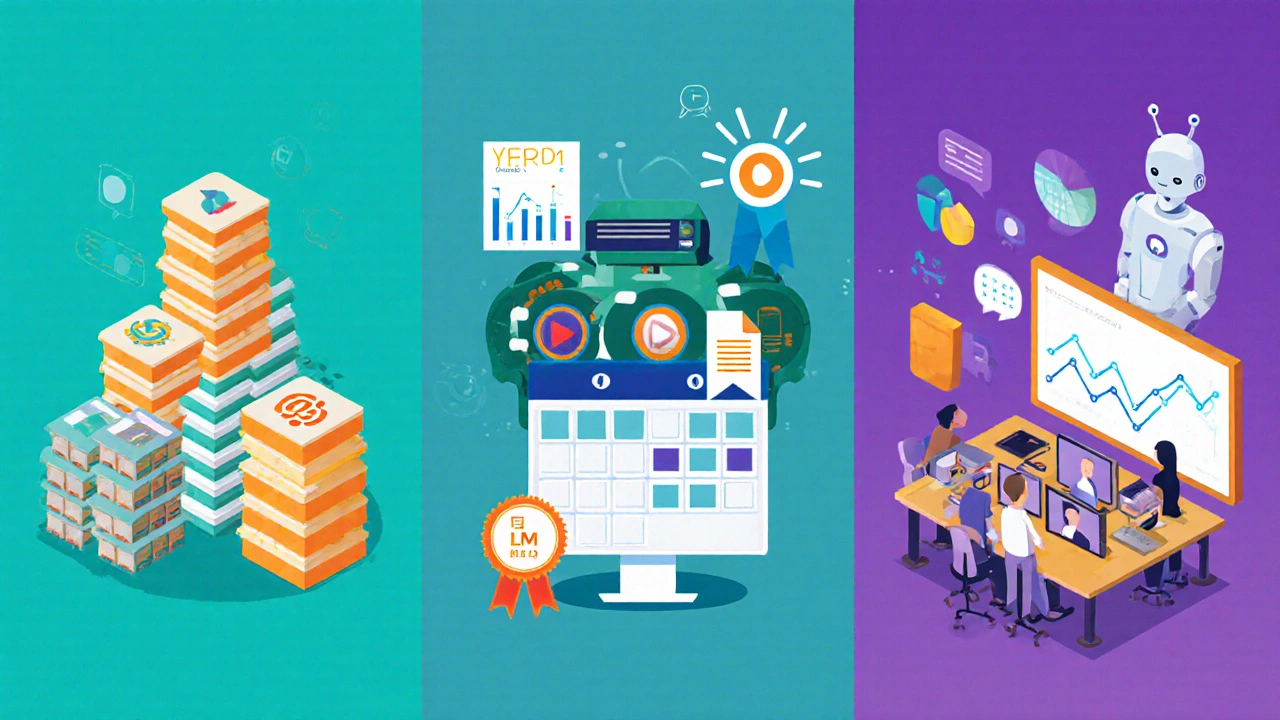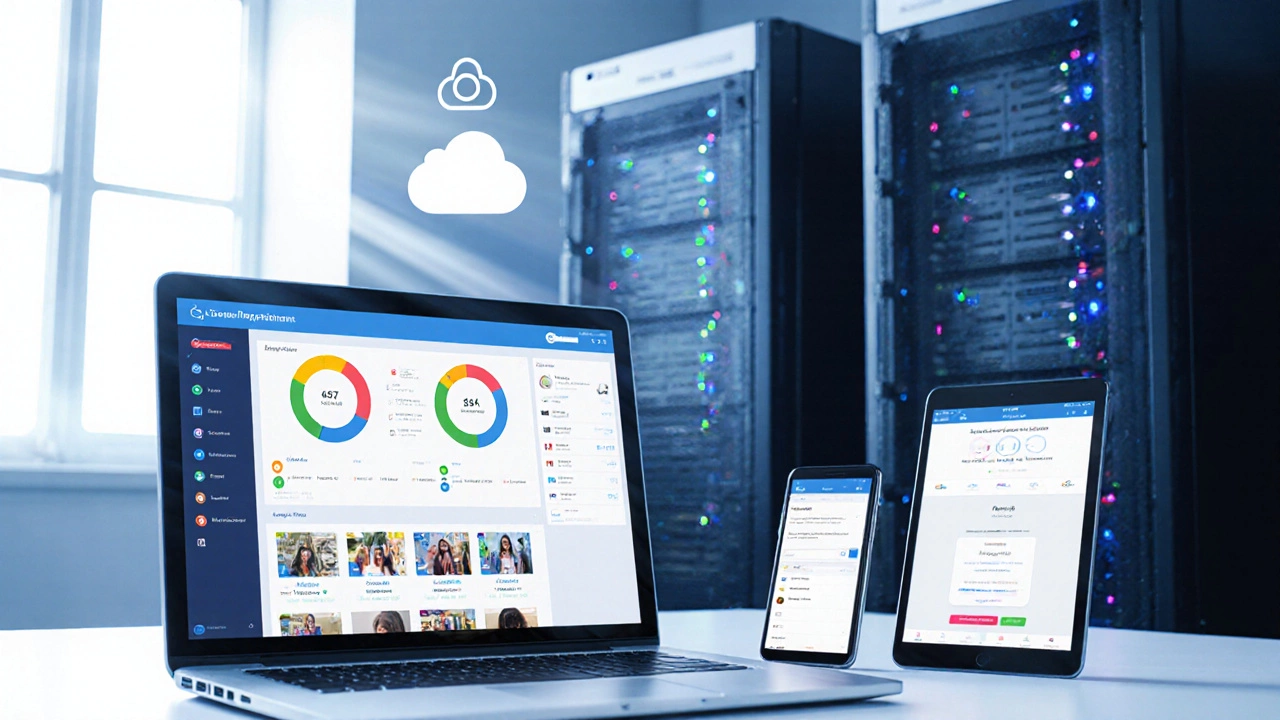When you hear the term Digital Learning Platform is a software suite that delivers, manages, and tracks educational content over the internet, you might picture a login screen or a video lecture. In reality, the ecosystem is far richer - it spans everything from a simple quiz app to a full‑blown university‑scale system that powers thousands of courses simultaneously.
Why digital learning platforms matter today
Schools, corporations, and independent creators all face the same pressure: make learning flexible, engaging, and measurable. A good platform lets a teacher upload a PowerPoint, a student submit an assignment, and an administrator see real‑time completion rates - all without leaving the browser. According to a 2024 Gartner report, organisations that adopted integrated platforms saw a 23% rise in learner completion rates and a 15% reduction in administrative overhead.
Core components you’ll find in any platform
- Content repository - stores videos, PDFs, SCORM packages, and other assets.
- Learning Management System (LMS) - the engine that schedules modules, issues certificates, and tracks progress. Learning Management System is software that organizes, delivers, and records learning activities.
- Virtual classroom - live video, breakout rooms, and whiteboard tools. Virtual Classroom refers to synchronous online teaching environments that simulate a real‑world classroom.
- Assessment engine - quizzes, peer reviews, and automated grading.
- Analytics dashboard - visualises engagement, dropout points, and skill mastery. Analytics Dashboard provides data visualisations that help educators make evidence‑based decisions.
- Adaptive learning - adjusts difficulty based on learner performance. Adaptive Learning uses algorithms to tailor content pathways to individual needs.
Popular delivery models
Not every institution needs the same level of complexity. Here are the three most common models:
- Self‑hosted LMS - you install the software on your own servers (e.g., Moodle, Canvas). Full control, but you handle updates and security.
- Cloud‑based SaaS - the vendor hosts everything (e.g., Google Classroom, Microsoft Teams for Education). Quick start, predictable pricing.
- MOOC platforms - massive open online courses that reach a global audience. MOOC stands for Massive Open Online Course, a publicly accessible course often provided by universities.

Feature‑by‑feature comparison of leading platforms
| Platform | Pricing (per active user) | Target audience | Key features | Integration depth |
|---|---|---|---|---|
| Moodle | Free (self‑hosted) / $2 USD for managed cloud | Universities & NGOs | Open‑source, SCORM compliance, extensive plug‑in library | High - API, LTI, webhooks |
| Canvas | $9 USD (basic) - $20 USD (enterprise) | Higher‑ed & K‑12 districts | Modern UI, mobile apps, competency‑based grading | Very high - SIS sync, Google Workspace, Microsoft 365 |
| Google Classroom | Free with Google Workspace for Education | K‑12 schools | Seamless Docs/Sheets/Drive integration, simple assignment flow | Medium - limited non‑Google apps |
| Microsoft Teams for Education | Included in Microsoft 365 Education (≈ $2 USD per user) | K‑12 & corporate training | Live meetings, Teams channels as courses, built‑in analytics | High - Office suite, Azure AD, third‑party LTI |
| Coursera for Business | $399 USD per employee per year | Enterprises seeking up‑skilling | Industry‑led MOOCs, skill tracks, certification | Medium - SSO, HRIS connectors |
How to pick the right platform for your needs
Start with three questions:
- Who are the learners? A university with 10,000 students needs scalability; a boutique coaching firm may prefer a sleek SaaS UI.
- What learning experiences matter most? If live labs are crucial, look for strong virtual‑classroom tools. If data‑driven interventions are a priority, the platform’s analytics must support custom dashboards.
- What’s the budget ceiling? Open‑source options reduce license fees but raise hosting costs. Cloud SaaS often includes support and reduces IT overhead.
Map the answers onto a decision matrix: score each platform on “Fit”, “Cost”, “Support”, and “Future‑proofing”. The highest total wins.
Emerging trends shaping the next generation
Even the best platforms today will look dated in a few years. Watch for these movements:
- Micro‑credentialing - bite‑sized certificates that stack into larger degrees.
- AI‑generated content - platforms that auto‑create quizzes from lecture transcripts.
- Immersive XR labs - virtual reality simulations for fields like medicine or engineering.
- Gamified pathways - Gamification adds points, leaderboards, and badges to boost motivation.
- Interoperability standards - SCORM and xAPI make it easier to move content between systems.
When evaluating a platform, ask whether its roadmap includes these capabilities. Future‑proofing saves you a costly migration later.
Implementation checklist - from pilot to full roll‑out
- Define learning objectives and map them to platform features.
- Run a pilot with a small user group; gather feedback on UI, load times, and reporting.
- Configure authentication (SSO, LDAP, or social login) to avoid login friction.
- Import or create content using SCORM, video, or live‑session formats.
- Set up analytics - choose key performance indicators (completion rate, engagement time, assessment scores).
- Train instructors on course authoring tools and virtual‑classroom etiquette.
- Launch institution‑wide and monitor the analytics dashboard daily for early issues.
- Iterate - tweak content, adjust pathways, and leverage adaptive learning algorithms.
Frequently Asked Questions
Frequently Asked Questions
How does a digital learning platform differ from a simple video‑hosting site?
A video host only stores media. A platform adds course structures, assessments, progress tracking, and analytics, turning passive watching into an interactive learning journey.
Is open‑source always cheaper than SaaS?
Not necessarily. Open‑source eliminates license fees but you still pay for hosting, maintenance, and technical staff. SaaS bundles those costs into a predictable subscription.
Can I mix and match platforms?
Yes, using LTI (Learning Tools Interoperability) you can embed a virtual‑classroom from one vendor into an LMS from another, creating a best‑of‑both‑worlds stack.
What data privacy standards should I look for?
Look for GDPR compliance if you serve EU learners, FERPA for US K‑12, and ISO/IEC 27001 for overall information security.
How quickly can I get a platform up and running?
A cloud SaaS like Google Classroom can be live within minutes. A self‑hosted solution like Moodle usually needs a few days for installation, configuration, and testing.
Understanding what a digital learning platform really offers helps you move beyond buzzwords and choose a tool that matches your education goals, budget, and tech capacity. Whether you’re a small tutoring business or a multinational corporation, the right platform can turn scattered content into a cohesive learning experience that scales, adapts, and delivers measurable results.
